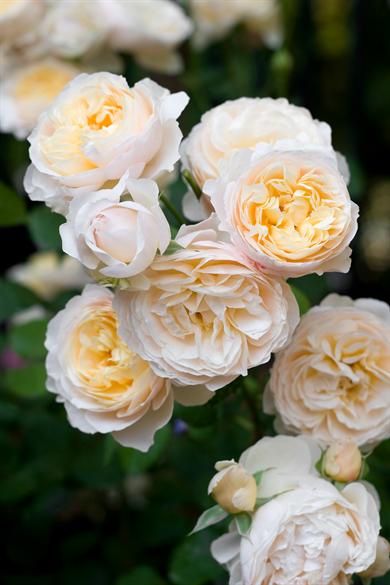“Pruning roses is essential as it encourages new growth and better flowers,” says garden designer Shirley Wallington, “and if you remember how they grow, it isn’t difficult to prune them”

I love the story of the English gardener who visited one of the famous temple gardens in Japan and asked the head gardener what was the secret to creating such beauty. The head gardener simply held up his pruning shears and smiled.
Whether they are bushes, shrubs or climbers, all roses grow in much the same way – strong shoots rise from the base of the plant, bear flowers for a couple of years and gradually decline and die, to be replaced by new growth from the base of the plant. Pruning removes the old and dead branches and trims away top growth that is too weak or twiggy to bear good flowers, in order to encourage vigorous new growth from the base.
SHRUBS AND BUSHES
Repeat-flowering roses bloom on the current year’s growth as well as on the side shoots from older wood and should be pruned in winter after any danger of frost has passed. The best time is July, although you can do the job any time from when the plants become dormant and start to lose their leaves to when the new growth begins.

- Firstly remove all dead wood and any old branches. These will have rough bark (young productive wood still has smooth bark).
- Remove all the spindly side shoots, and either cut them back to a strong young branch or right to the base. This will leave you with a bush made of branches from one to about three years old. The rule is that if a stem is thinner than an old-fashioned lead pencil, it is too thin to keep.
- Roses like good air circulation so remove those branches that cross over the centre to keep it open. Aim for a cup shape
- Then decide if you need to prune hard or lightly. Hard pruning involves cutting down the good branches to about a quarter of their length. The drawback of this is that it often shocks the plant and shortens its lifespan. These days most people favour shortening the branches by about a third. If your garden is very cold, then cut them to about half.
- If in doubt, prune lightly for a year or two; you could prune harder if the bushes start looking tall and leggy. Don’t try and keep a rose bush shorter than it wants to grow and don’t try to force it to be symmetrical. If it looks a bit lopsided after pruning, don’t worry as it will soon fill out with new growth.
- After pruning, sprinkle a handful each of 5:1:5 fertiliser and superphosphate around each bush and dig in to a depth of 20cm but don’t disturb the roots too much. Water in well. Then spread a layer of about 5cm of compost or manure on your rose beds and around specimen plants making sure that it doesn’t touch the stems.
- If your garden is susceptible to fungal diseases then spray all stems and cuts with a solution of one part lime sulphur to five parts water. If pernicious scale is evident, spray with Oleum (100ml to 10 litres water).
- Cover the beds with a good mulch. Peanut shells arean excellent option.
CLIMBERS
Climbing roses don’t ‘climb’ like ivy or jasmine does on a wall or fence and need to be trained and supported almost like an informal espalier.
Step 1. Firstly remove all the old branches as indicated in brown below.

Step 2. To encourage the maximum flowers, train most of the branches of climbers horizontally (pictured below) so that they’ll flower along the whole length. If left to grow upright they flower at their ends only.

NOTE: Ramblers like ‘Dorothy Perkins’ only bear flowers once; after one of their long, very flexible canes has flowered, it won’t flower well again. So simply cut the just-flowered branches right down to the ground when the flowers have faded and then train the new ones into place as they grow.
ROSE TIPS:
- When planting roses, group those of the same type and height together about 60–80cm apart so that there’s space for air to circulate. It also makes picking and deadheading much easier.
- Deadhead roses regularly to encourage them to bloom prolifically. However don’t remove too much foliage as they need leaves to manufacture food.
- To rejuvenate an old, neglected rose bush, prune it hard this winter then water and fertilise it lavishly in spring.

